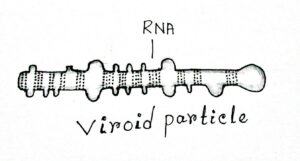Viroids are the group of pathogens of some higher plants. Theodor Otto Diener introduced the viroid in 1971 for a new group of sub-viral plant pathogens. He was the first to discover the causal agent (Potato Spindle Tuber Viroid or PSTVd) of potato spindle tuber disease.
Previously, the virus was identified as the smallest infectious agent. Although Viroids are the smallest known agents of infectious disease.
They are smaller and simpler than any of the viruses and consist of only single-stranded circular or linear RNA molecules without a protein coat (capsid).
Viroids Definition
Viroids are infectious particles, smaller than a virus that consists of a strand of naked RNA without a protein coat and is capable of causing disease in plants.
Characteristics Features of Viroids
- The viroid consists of naked single-stranded RNA without capsids.
- Infectious RNA has a very low molecular weight.
- The viroids themselves can automatically replicate in susceptible cells.
- Infectious RNA does not contain any protein-coding genes.
- They are the minute infectious agents of plants.

Examples
Some common Viroids are Potato spindle tuber viroid (PSTVd), Cucumber pale fruit viroid (CPFVd), Tomato bunchy top viroid (TBTVd), Citrus excortis viroid (CEVd), Chrysanthemum stunt viroid (CSVd).
Viroid Structure
- The viroid is made up of a protein-free, low molecular weight (75000-125000 daltons), naked single-stranded RNA.
- The single-stranded RNA is usually folded to form a linear or circular structure and appears double-stranded due to complementary base pairing at intervals.
- The number of nucleotides is 250-350 in each RNA molecule.
- The folded RNA possesses the following five regions – Left terminal domain (TL), Pathogenicity domain (P domain), Central Conserved region (CCR), Variable domain (V domain), and Right terminal domain (RT).
- RNA does not code any protein due to the absence of initiation of the codon.
Replication of Viroid
RNA-dependent replication
The viroids replicate by direct RNA to RNA coping. The RNA-dependent RNA polymerase present in plant cells helps in replicating the viroids (Branch and Robertson, 1984).
DNA-dependent replication
The viroids are transcribed from a cellular DNA host of the host cell complementary to viroid RNA with the help of reverse transcriptase. In the infected cell, new DNA is synthesized with the infecting viroid RNA which serves as a template.
